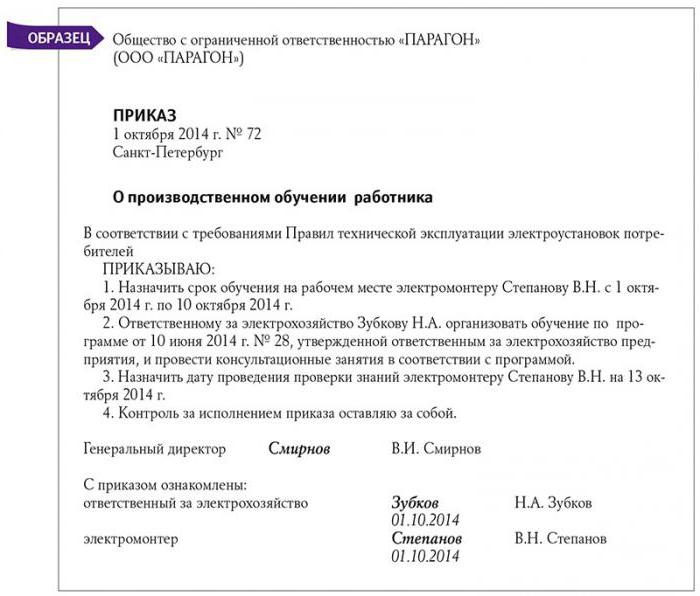If it is necessary to train employees in new tasks, the employer should proceed from the existing needs. They may relate to knowledge, skills and attitudes of staff towards customers or to their own responsibilities. For example, a seller in a clothing store is required to have high rates in all three parameters. He must be able to demonstrate a certain attitude towards the client, possess skills in sales and service, as well as work in the trading floor and knowledge of the sales procedure as such.
What is the best way to conduct training
There are only two types of it - training in a third-party educational institution or training on the job (directly at the workplace). The choice is determined by which of the methods will be used. This article is devoted to the second option, but for comparison we will try to consider both methods and identify the pros and cons of each, as well as some subtleties of paperwork.
The option of on-the-job training for an employee is practiced in a normal work environment. The one who is being trained uses real working tools and equipment, as well as the available material and documentation. It simultaneously combines the roles of apprentice and employee.

On-the-job training is provided outside the workplace. Most often, a simplified model of equipment and training tools is used. For the training period, the employee is not among the productive units. His work in this period is to complete training tasks.
This type of training is mainly carried out in separate specialized centers visited by employees of several different companies at once, as well as in colleges or courses.
On-the-job training is the main advantage
The advantages of this option at first glance are obvious:
1. Such an event is less expensive compared to on-the-job training, as it is carried out in a real working environment on existing equipment.
2. The effectiveness of on-the-job training is high due to the fact that in the future the employee will use the same materials, tools and mechanisms.
3. In the process, the student is immersed in the working atmosphere. He will not have to subsequently adapt to an unfamiliar team and dramatically change the "environment".

And now for the cons
But on-the-job training for an employee also has a number of disadvantages:
1. The closest workplace neighbor is often appointed as a mentor. He may not have the proper teaching skills or the right amount of time to devote a lot of attention to the ward.
2. In the case of piece-rate payment during training on the job, both the instructor and the student remain in the loser. Most likely, normal productive studies will not work.
3. In such an informal environment, there is a great risk of teaching a beginner the wrong working methods, for whatever reasons accepted in this team.
4. The result of the actions of an inexperienced employee can be a large number of defective products and spoiled raw materials.
5. There is a risk of failure of the equipment necessary for operation.
6. Work environment involves some stress. Most often, the work environment with its noise and bustle does not contribute to a calm and thoughtful comprehension of the wisdom of the profession. The student may be embarrassed by his inexperience and be afraid of the ridicule of colleagues.In such conditions, good results of training on the job cannot be spoken about.

Understanding certain skills is possible only in a working process. They require close interaction with the mentor. Often this applies to such varieties of work that are required in the production process not every day. There is no special need to specially teach them with a separation from production.
At the same time, there is no need to talk about high-quality theoretical training in working conditions. For this, the student will need to attend college.
Documentation of the procedure
The personnel department is responsible for training beginners at the enterprise. As a rule, there are no problems with the design of this procedure. But sometimes the cost of training is required to be excluded from the tax base. In this case, the accounting department will have to intervene in order to properly process the process.
When it comes to on-the-job training, things are a little more complicated than acquiring skills on the spot. It would be useful to draw up an annual plan for the training of employees. It will need to indicate the number of people sent to educational institutions in the current year, with justification of the purpose and reasons for this step.
The training order indicating the reasons for referral is signed by the director. The correct execution of such a document implies an indication of the specific tasks that need to be achieved. At the same time, for example, we can talk about updating theoretical and practical knowledge and skills related to certain specialties, the assimilation by employees of modern methods of solving production issues, etc.

How to get an employee to study
An organization (namely, it, and not an employee) must sign an agreement with an educational institution. In such an agreement, the type of educational service is indicated. In this case, we are talking about vocational training, advanced training or retraining. The training period and its cost are also affixed. Copies of the curriculum and educational institution license are usually attached to the contract.
The study of an employee is carried out by concluding an additional agreement to the employment contract. It puts down the name of the specialty or the level of qualification received by the employee based on the results of studies, lists the professional skills planned for mastering, indicates the order in which working hours will be paid if classes are supposed to be held on weekdays.
What to carry in tax
As a confirmation that the student is a full-time employee, you will need to remove a copy from his work book. Upon completion of training, the program will be used as the accounting documents received from the employee reflecting the questions passed, the certificate on the services rendered and (in the case of a commercial educational institution) an invoice.
In the case when it is supposed to study in another locality, it will be useful to attach travel documents and a hotel bill to the package of documents.
The document received by the employee upon completion of studies (certificate, certificate, certificate, etc.) should be copied. The reference to it should be in the order issued on this occasion. The main content of such an order will be an indication of the new position of the employee or an increased level of his qualifications.

Workshops and consultations
If we are talking about consulting seminars, a contract should be signed with a training company. The wording should emphasize the obligations of the seminar organizers to provide advisory services in the field that relates to the activities of the company.
In the same way, at the end of the study process, one should stock up on primary documents - an act of consulting services provided, a "report" from the seminar organizer, where the subject and composition of the issues discussed will be detailed in detail, an invoice and travel documents in case of "correspondence" studies.
On-the-job training: design
But back to the main topic of our article - training in the workplace. In this case, the issue of documenting problems arises an order of magnitude less.
Similarly, an annual plan should be drawn up on the number and composition of students with the reasons and goals of such studies. An order for on-the-job training is being prepared for each person sent, indicating the reasons for the need for retraining. If a visiting specialist or a representative of an educational institution will act as a teacher, you should definitely sign a contract with him.

When the mentor is someone from the company’s employees with a separate payment for teaching activities, it is necessary to draw up an additional agreement to the employment contract with him.
When sent to study on the job with employees, student contracts are drawn up. In this case, such a step is necessary. The contract specifies the specialty or qualification acquired by the employee, and the responsibilities of each of the parties are clearly formulated (the administration provides the opportunity for training, the employee undertakes to go through all its stages and then work for a certain period in the company).
The start date of studies should be fixed. If an employee is awarded a scholarship for this period, its size should also be specified in the contract.
When it comes to higher or secondary special education
You need to start in the same way with the preparation of an annual plan. A separate management order is issued for each employee with an indication of the form of training (evening, correspondence, and so on). An agreement with an educational institution must be concluded on behalf of the company. It is necessary to request the program of the institution and a copy of the license for the application to the contract.

With the employee is ext. the agreement is similar to the previous case, indicating the acquired qualification assigned according to the results of the study of the specialty and the procedure for paying for time worked. The diploma obtained must be copied in the same way and required from the employee similar primary documents, consisting of questions passed according to the curriculum, the act of providing services by the educational institution or an invoice if it is of a commercial nature.